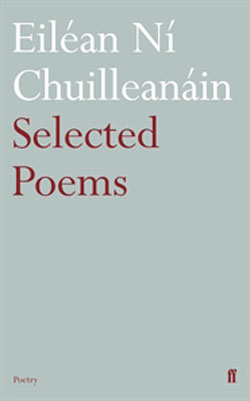Selected Poems
by Eiléan Ní Chuilleanáin, edited by Peter Fallon
reviewed by Meg Tyler
Edited by Peter Fallon, Selected Poems brings together the work from Eiléan Ní Chuilleanáin’s forty years as a poet, starting with the 1972 Acts and Monuments (which took its name from John Foxe’s sixteenth-century historiography of English Protestantism, also known as the Book of Martyrs), for which she won the Patrick Kavanagh Poetry Award, and ending with the 2001 volume, The Girl Who Married the Reindeer. In 1992, she was awarded the prestigious O’Shaughnessy Poetry Award by the Irish American Cultural Institute, which described her as “among the very best poets of her generation.” Ní Chuilleanáin is co-editor with her husband, the poet Macdara Woods, of the long-running literary journal Cyphers. And a cipher is a fitting emblem for her Selected Poems, as each poem gains in value when placed after the others.
Many of the poems seem to come straight from the cave of an enchantress. There is something about the atmosphere of this book that, when I close it, makes me feel as if I have been woken suddenly from a dream in mid-play. Disconnected images haunt the air, dark, portentous, and indecipherable. The poet describes things that are always there in front of us but that most of the time we are too preoccupied to see. In “Home Town,” she recalls returning from a bus journey and walking towards home,
Cutting through alleyways that jump at me.
They come bursting out of the walls
Just a minute before I began to feel them
Getting ready to arch and push.
Here she captures the disorientation caused by fatigue, or emotional intensity, adjusting to a different pace (walking) after being hurled down motorways at high speed. What interests Ní Chuilleanáin is the felt life—but not as opposed to the real one. A section from “Woman Shoeing a Horse” illustrates her deftness with enjambment and the vibrancy of her images:
. . . The hammer notes were flying
All urgent with fire and speed, and precise
With a finicky catch at the end—But the noise I could not hear was the shock of air
Crashing into her lungs, the depth
Of the gasp as she turned with a ready hand.As the heat from the fire drew up the chimney,
The flame pressing, brushing out the last thread,
Constantly revising itself upwards to a pure line.
One or two poems (“The Secret,” “Passing Over in Silence”) verge on the mystifying. But, as a reader, I find this less troubling than, say, mucking my way through much contemporary poetry, because her work seems to rise from a struggle with the unseen world. Poems like “The Witness” leave certain questions unanswered, but the simile at the close makes my confusion seem minor: “Beyond the walls I can hear the children playing / In the riverbed. If I could tell what they are crying / It would lighten my darkness like knowing the language of birds.” Inasmuch as there can be in a poem, there is a total absence of affectation here.
Some of the shorter (or short-lined) poems have an incantatory quality, and yet Ní Chuilleanáin never obviously borrows the meters of enchantment (iambic tetrameter). Her work descends in part from the spiritualist poems of Yeats, although she eschews the use of overt rhyme schemes. Rather, these are songs full of trust in the power of everyday noises, cycles of birth and death, the lasting impact of folk stories. One of the most convincing for me is “Street,” which has a satisfying fairy-tale-like logic to it. We want to believe in the story because of the matter-of-factness of the description rather than its symbolic import:
He fell in love with the butcher’s daughter
When he saw her passing by in her white trousers
Dangling a knife on a ring at her belt.
He stared at the dark shining drops on the paving-stones.One day he followed her
Down the slanting lane at the back of the shambles.
A door stood half-open
And the stairs were brushed and clean,
Her shoes paired on the bottom step,
Each tread marked with the red crescent
Her bare heels left, fading to the faintest at the top.
Poems such as “Pygmalion’s Image,” which depicts the stone carving of a mythological character found in a tangle of ferns, have similar moments of seeing the ordinary anew.
The work is not suffused with the too-personal: “In Her Other House” and “In Her Other Ireland” could refer either to the poet or to an everywoman figure, and this slight distancing adds to their timelessness. In Ní Chuilleanáin’s translation of a poem from the Irish, “Kilcash” (c. 1800), the narrator longingly describes a ruined estate, recalling its heyday: “Now at evening / the musical birds are stilled / And the cuckoo dumb in the treetops / that sang lullaby to the world.” The eternal and the mysterious have their place in these poems, even amid ones that elegize named friends and relatives. Fascinatingly, the later poems are not easy to distinguish from earlier ones; the intelligence, the ability to perceive deeply, is there from the get-go. This is a book to read and re-read with gusto, returning us to, as Heaney puts it, the idea of “poetry as divination, poetry as revelation of the self to the self.”
Published on March 6, 2015

